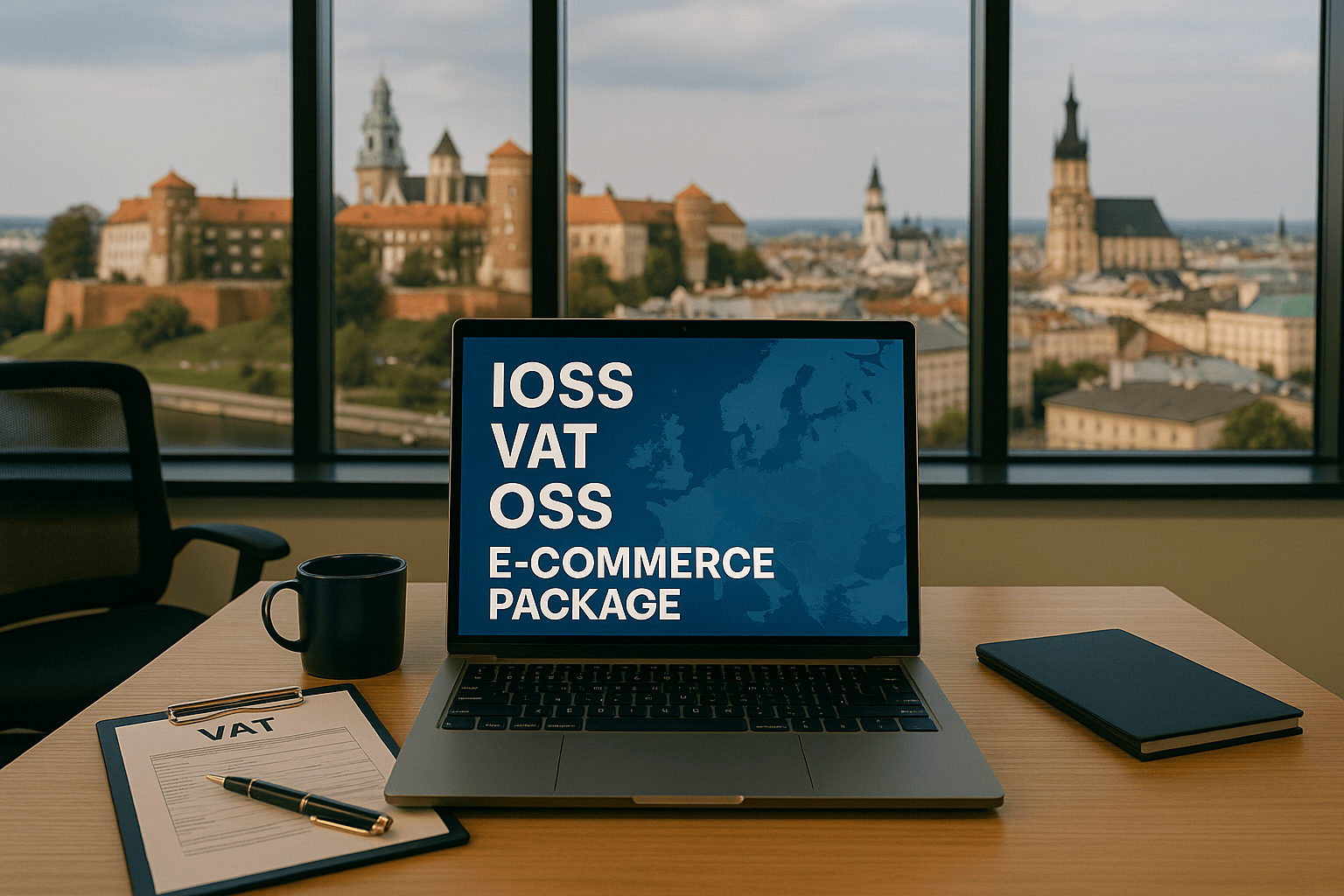Executive Summary
The EU VAT e-commerce package, implemented in July 2021, revolutionized how businesses account for VAT on cross-border sales. In Poland, the introduction of OSS (One Stop Shop) and IOSS (Import One Stop Shop) significantly changed VAT compliance rules for distance sales, import of low-value goods, and digital platforms. This article explains how businesses selling to EU consumers should register for VAT, obtain an IOSS number, account for VAT, and simplify compliance under the Polish VAT Act and EU rules. It also outlines the latest reforms under VAT in the Digital Age (ViDA) and their implications for sales in Poland and the entire European Union.
Introduction to the VAT E-commerce Package
The EU VAT e-commerce package entered into force on 1 July 2021, introducing sweeping changes to the taxation of cross-border distance sales of goods and services to consumers (B2C). The primary aim of this reform was to modernize VAT rules for the digital economy, simplify compliance, and ensure VAT is paid in the member state of consumption.
In Poland, these changes were implemented through amendments to the Polish VAT Act, aligning domestic rules with EU law. Businesses selling goods or services online now face new tax obligations, including the need to register for VAT under OSS or IOSS, depending on the nature of their transactions.

OSS: One Stop Shop for Distance Sales within the EU
The OSS procedure
The One Stop Shop (OSS) enables businesses to file a single VAT return in their country of establishment or, in case of non-EU companies, in the chosen member state of identification for all B2C distance sales of goods and certain supplies of services within the EU. Instead of registering for VAT separately in each EU country, a seller can declare and pay VAT centrally, and the tax authorities will distribute the VAT to the appropriate EU countries.
Benefits of OSS
- Simplifies VAT compliance for businesses engaged in cross-border distance selling.
- Eliminates the need for multiple VAT registrations across different EU member states.
- Ensures VAT is accounted for in the buyer’s country, applying the correct VAT rate.
- Covers supplies of goods and some services provided to EU consumers.
IOSS: Import One Stop Shop for Low-Value Goods
The IOSS procedure
The Import One Stop Shop (IOSS) applies to the sale of goods imported from outside the EU with a value of up to €150. Businesses using IOSS must obtain an IOSS number, register for VAT in one member state, and declare VAT on monthly IOSS VAT returns.
When the buyer orders goods online, the VAT is charged at the point of sale, collected by the seller or electronic interfaces (such as e-commerce platforms), and later remitted via the IOSS return. This avoids VAT collection upon import and simplifies customs clearance.
Key features of IOSS
- Applies only to goods ≤ €150.
- Excludes excise goods such as alcohol and tobacco.
- Sellers outside the EU must appoint an intermediary to use IOSS.
- VAT is charged based on the rate applicable in the EU member state of consumption.
VAT E-commerce Package in Poland
Polish VAT obligations
For businesses operating in Poland, the VAT e-commerce package means that:
- Sales of goods to EU consumers is subject to Polish VAT if the place of supply is Poland.
- For cross-border sales, VAT must be accounted for in the consumer’s member state via OSS.
- Low-value imports are declared through IOSS to simplify customs and VAT collection.
E-commerce platforms and electronic interfaces
Under the EU rules, e-commerce platforms and electronic interfaces facilitating sales may be deemed responsible for collecting and paying VAT on certain distance sales of goods. This shift ensures VAT is collected more efficiently and prevents tax evasion.
Registering for VAT and Compliance Steps
To comply with the EU VAT e-commerce package, businesses must:
- Register to OSS/IOSS in Poland or another EU member state.
- Decide whether to use OSS, IOSS, or both depending on the type of sales.
- Obtain an IOSS number if importing goods into the EU.
- File monthly or quarterly VAT returns, depending on the scheme.
- Keep accurate records for ten years, as required by the EU VAT Directive.
Failure to comply with these rules can result in penalties, additional VAT assessments, or restrictions on sales.
Challenges and Opportunities
Challenges for businesses
- Understanding different VAT rates across EU countries.
- Integrating IT systems with OSS/IOSS reporting requirements.
- Managing VAT obligations for both goods and services.
- Appointing intermediaries for non-EU sellers.
Opportunities and simplification
- OSS and IOSS significantly simplify compliance compared to pre-2021 rules.
- Buyers experience faster deliveries because VAT is settled at the point of sale.
- Businesses can expand across the EU market without complex VAT registrations.
VAT in the Digital Age (ViDA)
The next stage of VAT reform is VAT in the Digital Age (ViDA), approved by the EU in 2025. It introduces:
- Digital reporting and e-invoicing obligations (real-time VAT reporting).
- Extended OSS procedures covering additional supplies of goods and services.
- Clearer VAT rules for platform economies, treating platforms as deemed suppliers.
For Poland, this reform will interact with the national KSeF e-invoicing system, mandatory from 2026. While OSS and IOSS invoices are excluded from KSeF, businesses must align their reporting with both EU and Polish VAT rules.
Conclusion
The EU VAT e-commerce package has reshaped the way businesses handle VAT obligations in Poland and across the European Union. By using OSS and IOSS, companies can declare and pay VAT through simplified procedures, avoid multiple VAT registrations, and ensure compliance with EU law.
For businesses selling goods or services to EU consumers, especially through e-commerce platforms, understanding and applying these rules is essential to remain competitive. With the upcoming ViDA reforms and mandatory KSeF in Poland, companies should prepare early to integrate tax compliance into their digital strategies.
You can find more information here : https://www.podatki.gov.pl/vat/abc-vat/procedury/punkt-kompleksowej-obslugi-oss-i-ioss/
https://vat-one-stop-shop.ec.europa.eu/index_en


